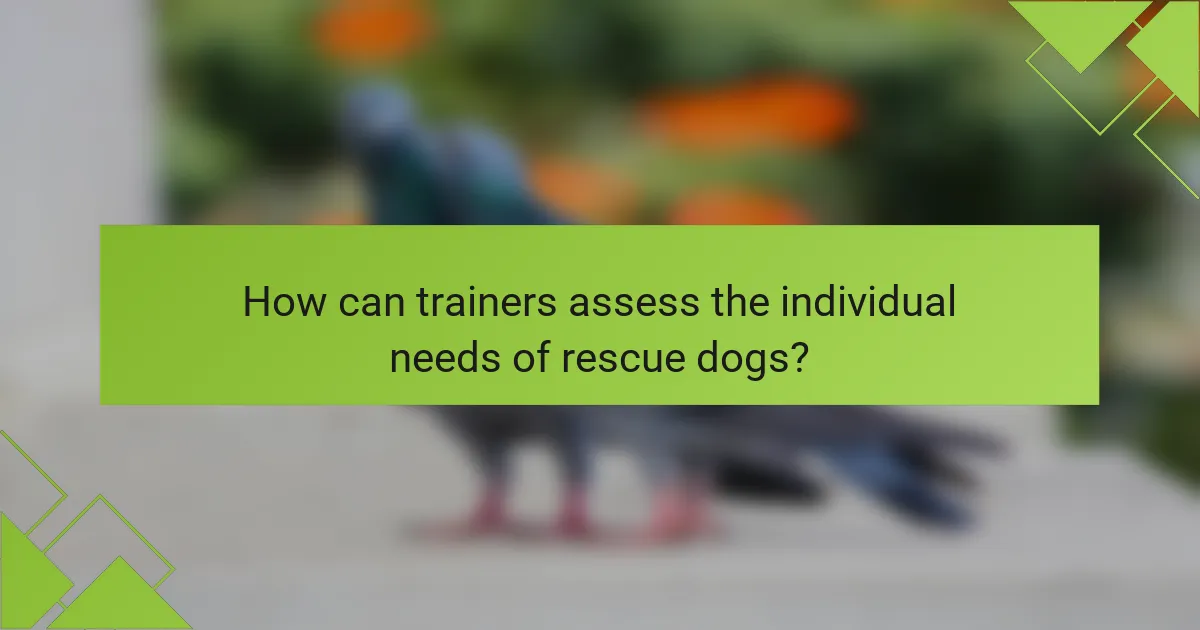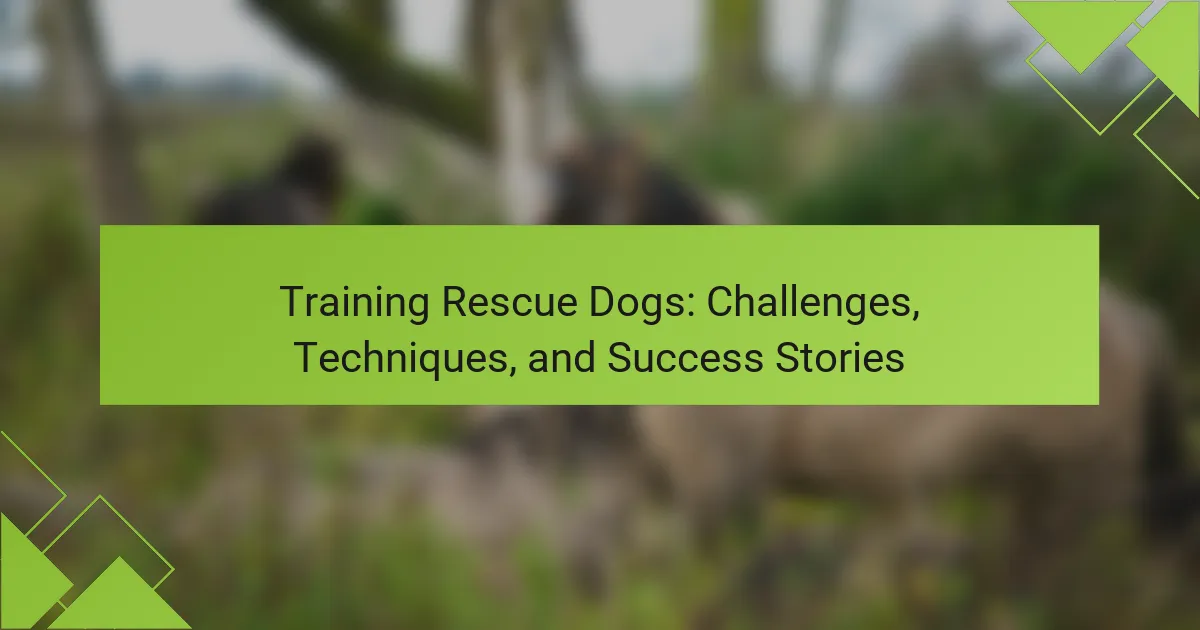Training rescue dogs presents unique challenges, including behavioural issues and emotional trauma. Effective techniques like positive reinforcement and socialisation are essential. Success stories illustrate the remarkable capabilities of trained rescue dogs. Resources and emerging trends support trainers in overcoming obstacles and fostering successful outcomes.

What are the primary challenges in training rescue dogs?
Training rescue dogs involves various challenges that can hinder their effectiveness. Key challenges include behavioural issues, inconsistent training methods, and the emotional impact of prior trauma on the dogs. Behavioural issues often stem from anxiety or fear, making it difficult for the dogs to focus during training sessions. Inconsistent training methods can lead to confusion and slow progress, as different handlers may use varying commands or techniques. Additionally, rescue dogs may have experienced trauma, which can affect their trust and willingness to engage, complicating the training process. Addressing these challenges requires patience, specialised techniques, and a deep understanding of canine behaviour.
How does the dog’s breed influence training challenges?
Dog breed significantly influences training challenges due to varying temperaments, intelligence levels, and energy requirements. Breeds like Border Collies are highly trainable but require mental stimulation, while stubborn breeds like Bulldogs may resist commands. Rescue dogs often combine traits from multiple breeds, complicating training. Understanding these unique attributes helps tailor techniques for success.
What psychological factors affect rescue dog training?
Psychological factors significantly influence rescue dog training. Key aspects include the dog’s past experiences, temperament, and socialisation. Dogs with traumatic histories may exhibit fear or anxiety, impacting their ability to learn. Training techniques must adapt to these psychological needs, employing positive reinforcement to build trust and confidence. Understanding these factors enhances the effectiveness of training, leading to better outcomes for both the dog and handler.
Which environmental conditions impact training success?
Environmental conditions such as temperature, humidity, and terrain significantly impact training success for rescue dogs. Extreme heat or cold can hinder performance and focus. High humidity can lead to fatigue, while challenging terrains require specific training techniques. Additionally, the presence of distractions, like wildlife or crowds, can affect a dog’s ability to concentrate during training sessions. Understanding these factors ensures effective training and optimal outcomes.

What techniques are most effective for training rescue dogs?
Positive reinforcement, socialisation, and consistency are the most effective techniques for training rescue dogs. Positive reinforcement encourages desired behaviours through rewards. Socialisation helps dogs adapt to various environments and situations. Consistency in commands and routines builds trust and understanding between the dog and trainer.
How does positive reinforcement improve training outcomes?
Positive reinforcement significantly enhances training outcomes for rescue dogs by encouraging desired behaviours. This method fosters a positive learning environment, leading to improved retention and responsiveness.
Using treats, praise, or play as rewards, trainers can effectively motivate dogs to learn commands and tasks. Research shows that dogs trained with positive reinforcement exhibit higher levels of engagement and lower stress compared to those trained with aversive methods.
Additionally, this approach builds trust between the dog and trainer, facilitating a stronger bond. A well-established relationship enhances the dog’s willingness to learn and obey commands, crucial for rescue missions.
In summary, positive reinforcement not only improves training success but also contributes to the overall well-being of rescue dogs, making it a preferred technique among trainers.
What role do socialisation and exposure play in training?
Socialisation and exposure are crucial in training rescue dogs as they enhance adaptability and reduce anxiety. Proper socialisation helps dogs develop confidence and appropriate behaviours around various stimuli. Exposure to different environments, people, and animals prepares them for real-life rescue scenarios. This foundational experience fosters a resilient and versatile canine, essential for effective rescue operations.
Which training methods are recommended for specific rescue situations?
Training rescue dogs for specific situations requires tailored methods. For example, tracking training is essential for search and rescue missions, while water rescue training focuses on swimming and retrieval techniques. Obstacle course training enhances agility for urban rescues. Each method addresses unique challenges faced in various environments, ensuring dogs are well-prepared for their roles.

How can trainers assess the individual needs of rescue dogs?
Trainers can assess the individual needs of rescue dogs through observation, behaviour assessment, and environmental evaluation. First, trainers observe the dog’s reactions to various stimuli to identify stress triggers. Next, they conduct behaviour assessments to understand the dog’s temperament and socialisation needs. Finally, evaluating the dog’s living environment helps tailor training methods to suit its unique circumstances. This comprehensive approach ensures effective training strategies.
What behavioural assessments are useful for understanding rescue dogs?
Behavioural assessments for understanding rescue dogs include temperament testing, socialisation evaluations, and stress response observations. These assessments help identify each dog’s unique needs and potential challenges in training. Temperament tests gauge a dog’s reactions to various stimuli, while socialisation evaluations assess their interactions with people and other animals. Stress response observations reveal how dogs cope with new environments, which is critical for tailoring effective training techniques.
How can trainers tailor their approach to different dogs?
Trainers can tailor their approach to different dogs by assessing each dog’s unique background, temperament, and learning style. Understanding a dog’s history, especially for rescue dogs, helps trainers identify specific challenges and needs.
For example, a shy dog may require a gentle, patient approach, while a more confident dog may thrive with assertive training techniques. Adapting the training environment, using positive reinforcement, and incorporating play can enhance engagement and learning.
Additionally, recognising rare behaviours or fears in individual dogs allows trainers to create personalised strategies, ensuring effective training outcomes.

What are some success stories of trained rescue dogs?
Trained rescue dogs have achieved remarkable success in various scenarios. For example, search and rescue dogs have located missing persons in disaster zones, showcasing their keen sense of smell and training. Therapy dogs have provided emotional support to individuals in hospitals, improving mental health outcomes. Additionally, detection dogs have played crucial roles in identifying explosives or narcotics, enhancing public safety. These stories highlight the effectiveness of training techniques and the unique abilities of rescue dogs.
Which rescue organisations have notable training programmes?
Organisations with notable training programmes for rescue dogs include the American Kennel Club, National Search Dog Alliance, and the International Association of Canine Professionals. These organisations focus on specialised training techniques to enhance the skills of rescue dogs. For example, the American Kennel Club offers a Canine Good Citizen programme that emphasises obedience and socialisation. The National Search Dog Alliance provides guidelines for training dogs in search and rescue operations. The International Association of Canine Professionals promotes professional standards in training methods for various working dogs. Each organisation contributes to the overall effectiveness of rescue operations through rigorous training protocols.
How have trained rescue dogs made a difference in their communities?
Trained rescue dogs significantly enhance community safety and support during emergencies. They assist in locating missing persons, detecting hazards, and providing emotional support. Their training equips them with specialised skills, improving response times and effectiveness in crisis situations. Success stories highlight their impact, such as finding survivors in disaster zones or helping in search and rescue operations. Communities benefit from their presence, fostering trust and resilience in challenging times.

What common mistakes should trainers avoid when working with rescue dogs?
Trainers should avoid common mistakes such as rushing the training process, ignoring the dog’s past trauma, and using harsh correction methods. These errors can hinder progress and damage trust. Additionally, failing to adapt techniques to individual dog needs can lead to frustration. Consistency and patience are essential for success with rescue dogs.
How can trainers ensure consistent communication with rescue dogs?
Trainers can ensure consistent communication with rescue dogs by using clear, repetitive commands and positive reinforcement. Establishing a routine helps dogs understand expectations. Consistency in tone and body language reinforces commands. Regular training sessions build trust and improve communication.
What are the best practices for ongoing training and reinforcement?
Ongoing training and reinforcement for rescue dogs should focus on consistency, positive reinforcement, and gradual progression. Regular practice sessions enhance skills and build confidence. Incorporating play into training can increase engagement and motivation. Use varied environments to generalise commands and behaviours.
How can trainers manage unrealistic expectations during the training process?
Trainers can manage unrealistic expectations by setting clear, achievable goals. Open communication with dog owners about the training process is essential. Regular progress updates help align expectations with reality. Providing education on dog behaviour can also mitigate misunderstandings. Lastly, celebrating small successes fosters a positive training environment.

What resources are available for trainers of rescue dogs?
Numerous resources are available for trainers of rescue dogs, including online courses, specialised literature, and community support groups. Online platforms offer training modules tailored to rescue dog behaviour, while books provide insights into effective techniques. Additionally, local shelters often host workshops and seminars, fostering a network for sharing experiences and strategies. Access to experienced trainers and behaviourists is crucial for overcoming unique challenges faced in rescue dog training.
Which online platforms offer training courses for rescue dogs?
Online platforms that offer training courses for rescue dogs include Udemy, Coursera, and PetSmart. These platforms provide various courses focusing on training techniques, behavioural challenges, and success stories.
Udemy offers a range of courses tailored to different aspects of rescue dog training, including obedience and socialisation techniques. Coursera collaborates with universities to provide more structured courses that cover animal behaviour and training methodologies. PetSmart offers in-person and online classes specifically designed for rescue dogs, focusing on practical skills and behavioural assessments.
These platforms cater to diverse learning styles and needs, ensuring effective training for rescue dogs.
What books and publications are recommended for further learning?
For further learning about training rescue dogs, consider these recommended books and publications.
1. “The Art of Training Your Dog” by K9 Training Institute
2. “Rescue Dog Training: A Guide to Training Your Rescue Dog” by Karen Overall
3. “Training the Hard-to-Train Dog” by Kelsey Whelan
4. “The Rescue Dog Handbook” by Julie K. Smith
5. “Positive Reinforcement Training for Dogs” by Dr. Sophia Yin
6. “Dog Training for Dummies” by Gary Gunn and Janet Heimlich
How can trainers connect with local support networks and communities?
Trainers can connect with local support networks and communities by attending events and workshops. Engaging with local animal shelters and rescue organisations fosters collaboration. Building relationships with veterinarians and pet supply stores can also provide valuable resources. Utilizing social media platforms helps trainers reach a broader audience and share their success stories.

What future trends are emerging in rescue dog training?
Emerging trends in rescue dog training focus on positive reinforcement, technology integration, and individualised approaches. Trainers increasingly use clicker training to enhance communication and reward-based techniques to build trust. Technology like virtual reality is used for simulating real-world scenarios, improving preparedness. Additionally, personalised training plans cater to each dog’s unique needs, promoting better outcomes and fostering successful adoptions.
How is technology shaping the training of rescue dogs?
Technology is significantly enhancing the training of rescue dogs. Advanced tools such as GPS tracking, drones, and specialised software improve training efficiency and effectiveness.
GPS devices help trainers locate dogs during search missions, ensuring they cover vast areas quickly. Drones provide aerial views, allowing trainers to assess environments and plan training scenarios effectively.
Additionally, virtual reality simulations create realistic training environments, exposing dogs to various situations they may encounter in real rescues. Data analytics track performance metrics, helping trainers tailor programmes to individual dogs’ needs.
These technological advancements lead to better-trained rescue dogs, ultimately improving success rates in real-life rescue operations.
What innovations are being introduced in training methodologies?
Innovations in training methodologies for rescue dogs include positive reinforcement techniques, technology-assisted training, and individualised training plans. These methods enhance learning and adaptability in various environments. For example, clicker training improves communication between trainers and dogs, while virtual reality simulations prepare dogs for real-life rescue scenarios. Additionally, incorporating behaviour analytics helps tailor training to the unique needs of each dog, leading to more effective outcomes.
How can trainers adapt to changing societal needs for rescue dogs?
Trainers can adapt to changing societal needs for rescue dogs by incorporating modern techniques and community feedback. They should focus on positive reinforcement methods that align with current understanding of canine behaviour. Additionally, trainers can develop programmes that address specific challenges, such as anxiety or aggression, which may arise from a dog’s past experiences. Engaging with local organisations helps trainers stay informed about community needs, fostering successful placements for rescue dogs.
What expert tips can enhance the training experience for rescue dogs?
Positive reinforcement, consistency, and socialisation are key expert tips to enhance the training experience for rescue dogs. Establish clear commands and routines to build trust. Incorporate play and rewards to motivate learning. Regular social interactions with other dogs and people can reduce anxiety and improve behaviour.
